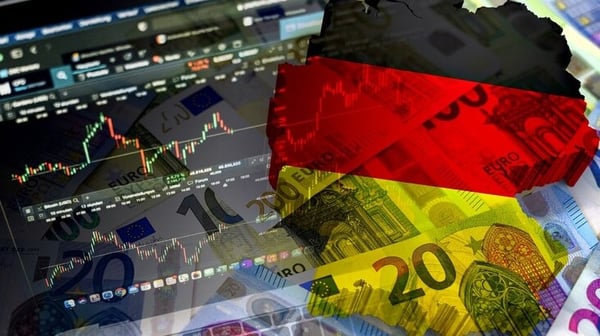Disclaimer: Views in this blog do not promote, and are not directly connected to any L&G product or service. Views are from a range of L&G investment professionals, may be specific to an author’s particular investment region or desk, and do not necessarily reflect the views of L&G. For investment professionals only.
Germany unleashes defence spending – what is it good for?
Not bond investors (maybe).

After more than a decade of fiscal conservatism, Europe looks set to embark on a huge increase in defence spending. This would be to fill the void left as the US potentially pulls back from military commitments on the continent, and even threatens to leave NATO.
Most interestingly, this initiative is being championed by Germany – for so long the poster child of fiscal prudence, but now feeling vulnerable to the war occurring on her doorstep. With Germany driving this change, the likelihood of follow-through with the plans is high, and the political will behind them seems strong.
There have been major developments at both the German national and European Union levels. Since 2009, German spending has been constrained by the Schuldenbremse (debt brake), which was added to the constitution after the global financial crisis. This stated the structural deficit must not exceed 0.35% GDP at the federal level, and 0% at the state level. While it has been a popular measure among voters, support for it has waned as budgets have become more challenging post-pandemic, uncertainty over the US military alliance has made it untenable. Hence, Germany is now hurrying to enact constitutional reform before the parliamentary maths make it significantly more complicated after the new session begins on March 25.
Since 2022, German defence spending has been supplemented by a special purpose fund, approved by super majority to circumvent the debt brake. However, this €100bn pot was due to be exhausted by 2027. Recent calls to increase military spending to between 3 and 3.5% of GDP per annum have superseded this time limit and represent the country’s largest structural reform for decades.
There is to be no replenishment of the Bundeswehr. Defence spending will instead move onto the balance sheet, meaning it is a permanent solution and not a stopgap. Spending in excess of 1.5% of GDP will be excluded from the debt brake calculation, making it unconstrained and able to meet a dynamic target. Second, a new €500bn fund is to be set up for infrastructure spending over the next decade. To ensure Germany continues her commitment to the green transition, €100bn will be dedicated to green projects. Thirdly, the debt brake at the state level will be amended to match the federal limit of 0.35%. With a large chunk of infrastructure spending occurring at the state level, this should smooth the transition.
Taken together, this amounts to around €1 trillion additional spending over the next 10 years (around 23% of German GDP).
Europe turns on the taps
But the reforms go beyond Germany. The European Commission has proposed additional measures that will help other member states to increase their defence spending. It proposes adding an escape clause to the new fiscal rules – themselves only reintroduced this fiscal year for the first time since the pandemic. This clause will exclude defence spending from deficit calculations for the next four years, theoretically freeing up budgets to meet the increase in military spending needs. While a figure of upward of €600bn has been spoken of, it is likely only to be a theoretical ceiling as many countries do not enjoy the same budgetary luxuries as Germany. Eight countries are under excessive deficit procedures (EDPs), given large deficits and debt ratios well above the 60% target specified in the Stability & Growth Pact that maintains the monetary union. Nevertheless, it shows a political commitment from Europe to stand up to Russia ahead of Trump’s negotiations over Ukraine.
On top of the escape clause, the Commission has also announced a €150bn fund for defence spending, a plan to allow the reallocation of cohesion funds, and an intention to lean more heavily on the European Investment Bank for additional military spending – theoretically adding an additional €1 trillion of funding at the European level to match that at the German level. The aims are Herculean and the numbers are huge; what could this mean for growth?
The impact on growth
A lot will depend on how quickly spending is increased and how the money is spent. Greater urgency to become self-sufficient militarily would mean a larger boost to near-term growth, but if forced to raise spending on domestic balance sheets with temporary flexibility, countries under EDPs may choose to drag their feet.
Additionally, Europe does not currently have the capacity to meet increased demand for military equipment, meaning that at least in the early years, hardware orders are likely to be placed externally (with the US the most likely to benefit). That makes the fiscal multiplier lower. There are many unknowns, but it is likely that Europe will want to replicate satellite coverage currently provided by US hardware. However, this type of spending takes a long time to come to fruition. Overall, we are removing our downside risks to European growth, even given ongoing trade war concerns.
But will the plans go further?
Even if the problem of feet-dragging is overcome, the current package of measures could lead to an unhelpful rise in yields as many countries increase their borrowing at the same time. The calls for joint issuance are likely to grow louder, especially from countries for whom such borrowing would be cheaper. Actions seen across Europe thus far tell us that this is seen as a crisis significant enough for inventive thinking and drastic action – exactly the sort of scenario which could breed more unity and constructive discussion around joint solutions.
With a structure already in place to raise debt at a European level, we should not rule out the leveraging of this structure. However, the significant uplift in issuance is likely to lean on bonds and we would expect to see them continue to underperform relative to swaps – something we have learned to expect in circumstances where supply has been of the magnitudes we now expect in Europe.
Meanwhile, equity investors have woken up to the opportunity created by these dynamics. One of the stocks at the heart of the German defence industry – Rheinmetall* - has now gained more than 2,000% over the last five years, well in excess of the American leaders of the AI revolution. The change is real, but equity investors do have a habit of over-extrapolating trends, no matter how positive. We're probably not there yet - valuations of the defence names are not extreme - but we'll need to remain attentive to the risk of excessive investor optimism.
*For illustrative purposes only. Reference to a particular security is on a historic basis and does not mean that the security is currently held or will be held within an L&G portfolio. The above information does not constitute a recommendation to buy or sell any security.
Recommended content for you
Learn more about our business
We are one of the world's largest asset managers, with capabilities across asset classes to meet our clients' objectives and a longstanding commitment to responsible investing.


